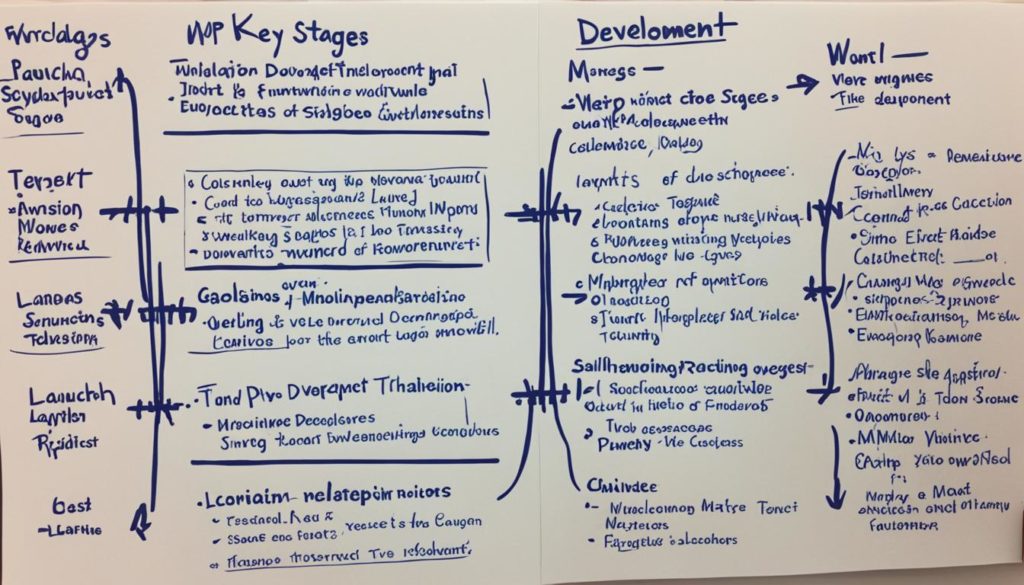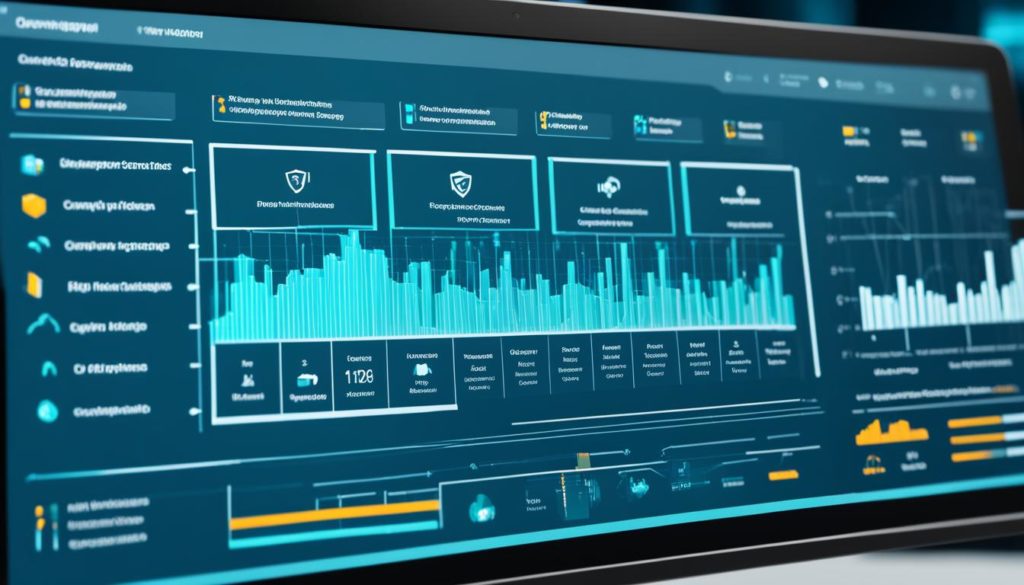
Did you know nearly 90% of data breaches come from phishing attacks? This figure highlights the urgent need to stop online fraud. Phishing methods are getting smarter. Examples include the 0ktapus phishing case in August 2022. It stole 9,931 user credentials and 5,441 multi-factor authentication (MFA) codes.
More businesses now use SMS two-factor authentication (2FA) for extra security. Yet, the dangers still grow. Phishing kits available through Phishing-as-a-Service (PhaaS) offer tools for easy and effective attacks. These kits let even beginners launch serious threats. This makes strong online fraud prevention more crucial than ever for both individuals and companies.
Key Takeaways
- Nearly 90% of data breaches are tied to phishing, highlighting the importance of email phishing protection.
- Phishing-as-a-Service (PhaaS) gives out comprehensive attack kits, making it easier for cybercriminals to start.
- The 0ktapus scam shows the growing complexity of phishing, with thousands of credentials and MFA codes stolen.
- Companies turning to SMS two-factor authentication (2FA) is a move against these changing threats.
- Tools like AppOmni provide key security services, like risk assessments, to help fight phishing.
The rise in phishing-related breaches tells us to learn more and act against email phishing protection. Knowing the signs of phishing and how these scams work can protect our personal and company data better.
How Phishing as a Service Facilitates Cybercrime
Phishing as a Service (PhaaS) offers cybercrooks ready-to-use phishing kits and help. This has made cybercrime easier for them, and the threat is growing. Now, attackers can easily set up scams and hack into systems.
What is Phishing as a Service?
PhaaS works like the Software as a Service (SaaS) models but for phishing. One PhaaS provider, called LabHost, helped set up over 40,000 phishing sites. They stole lots of credit card numbers and passwords. Payments in Bitcoin and Ethereum make tracing them hard.
Common Techniques Used by Phishing Service Providers
These services use many tricks to better their chances. They offer:
- Phishing Kits: These are fake pages that look real.
- Technical Support: Help on running a phishing attack smoothly.
- Dynamic URLs: These are special links that help avoid security checks.
For example, Caffeine lets users tweak URL patterns. Learn more in this overview of Caffeine phishing services.
The Impact on Individual and Corporate Security
PhaaS harms both people and companies. It makes stealing data easier, increasing breaches and financial losses. For instance, LabHost led to big losses and lots of stolen data.
An investigation of LabHost reveals its financial and security damage. The fight against these crimes is ongoing, with groups like Europol leading the charge.
Recognizing Phishing Emails and Messages
Learning to spot phishing emails and messages is key to keeping safe. Knowing what to look for helps us avoid identity theft and other harms.
Signs of a Phishing Email
Phishing attacks use scary mails. They want you to act fast. Look out for:
- Poor spelling and grammar
- Generic greetings (e.g., “Dear Customer”)
- Unfamiliar sender email addresses or mismatched domains
- Suspicious links or unexpected attachments
Stopping a phishing scam starts with being alert for these clues.
How Cybercriminals Lure Victims
Cybercriminals have many tricks. They might text or call, pretending to be someone you trust. Watching for these signs assists in spotting harmful websites:
- Claims of account compromise demanding immediate action
- Fake alerts about unauthorized transactions
- Promises of rewards or monetary incentives
Always check with the real company to make sure messages are true.
Examples of Suspicious Links and Attachments
Be on the lookout in emails. Phishing tries to trick with:
- Links that don’t match the real site’s URL
- Attachments named “Invoice” or “Receipt”
Dodging these tricks greatly helps in avoiding phishing scams. If caught in a scam, change passwords, use extra security, and tell the authorities.
Types of Phishing Attacks: From Email to Social Engineering
Phishing attacks come in many shapes, from wide email blasts to detailed social engineering plans. Knowing the various types is key for everyone’s cyber safety.
Email Phishing
Email phishing is a top cyber threat today. Scammers send fake emails, posing as real companies, to steal info. Making our Email phishing protection better can help stop these attacks.
Spear Phishing
Spear phishing goes after certain people or groups with tailored messages. Criminals do their homework to make these messages look real. That’s why spear phishing prevention is a must for cyber safety.
Smishing and Vishing
Smishing and vishing trick people through texts and calls. We trust our phones, so we must be wary of strange messages. Being smart about social engineering tactics helps fight smishing and vishing.
Malvertising and Search Engine Phishing
Malvertising spreads malware through bad ads. Search engine phishing tricks people with fake websites in search results. Knowing these tricks can boost our email phishing protection and keep us safe online.
| Phishing Method | Description | Prevention Tactics |
|---|---|---|
| Email Phishing | Generalized phishing emails sent to numerous recipients. | Enhanced email filters, staff training. |
| Spear Phishing | Targeted attacks on specific individuals or organizations. | Personalized training, advanced threat detection. |
| Smishing and Vishing | Phishing through SMS and phone calls. | Mobile security solutions, awareness programs. |
| Malvertising | Malicious advertisements that spread malware. | Ad-blockers, limiting exposure to unknown ads. |
| Search Engine Phishing | Fake websites appearing in search results. | Secure browsing practices, up-to-date antivirus software. |
Protecting Against Phishing: Best Practices and Tools
Cyber threats keep changing, so staying ahead with strong cybersecurity is key. Using smart strategies and tools can really lower phishing risks.
Implementing Multi-Factor Authentication
Multi-factor authentication greatly boosts account security. It makes sure access is only given after several checks. These include a password, a device like a phone, and often a fingerprint or face scan.
Employee Education and Awareness
Knowing what to watch out for makes workers a strong first defense. Training programs help spotlight shady emails. Learning about new phishing tricks is vital too.
Using Advanced Threat Protection Services
Advanced services offer real-time protection to spot and stop phishing. They use smart tech like AI to catch suspicious activity. Updating these services means ongoing defense.
Bringing together cybersecurity services, multi-factor authentication, training, and advanced threat protection builds a solid defense. Keeping up these efforts makes sure we stay safe from cyber dangers.
Pretexting vs. Traditional Phishing
Phishing is a big threat online, but not every phishing attack is the same. Pretexting is different from ordinary phishing because it is more sophisticated and focuses on specific targets.
What is Pretexting?
Pretexting is when attackers make up a story to get sensitive information. It’s different from other phishing attacks because it’s based on detailed research. This makes the lie seem real.
How Pretexting Differs from Other Phishing Methods
Pretexting and other phishing methods are not the same in how personalized they are. While normal phishing uses generic emails for many people, pretexting aims at specific individuals with realistic scenarios. This makes pretexting harder to spot and stop.
Examples of Pretexting Scenarios
Pretexting scenarios can be quite complex. For example, someone might pretend to be IT support and trick an employee into giving their login info. They might also act like a trusted vendor asking for payment details. These fake scenarios use trust and normal work habits against a company.
Protective Measures Against Pretexting
Stopping pretexting attacks needs careful attention and solid defenses. Here are some ways to protect ourselves:
- Verify Identities: Always make sure of who is asking for sensitive info, especially if it’s unexpected.
- Limit Personal Information Shared Online: Be careful with what you post on social media and professional sites. Criminals use this information to make their lies more believable.
- Educate Employees: Teaching employees about pretexting can help them spot and avoid these tricks.
Knowing the difference between pretexting and regular phishing helps in creating strong defenses. By following these steps, we can greatly lower our chances of being tricked by pretexting.
Conclusion
As we end our look into phishing as a service, we see the danger it brings to our online safety. Phishing methods get more complex, going after both individuals and companies. It’s key to know the signs of phishing to prevent online fraud.
To keep personal information safe, we need a range of strategies. Using multi-factor authentication, teaching employees, and using better threat protection helps. Pretexting, a tricky phishing type, shows why strong security and being alert are important.
In short, keeping safe online means staying informed and watchful. By following these cybersecurity tips, we can cut down the risk of phishing attacks. Let’s all make online safety a top priority to guard against these growing cyber threats.
FAQ
What is Phishing as a Service (PhaaS)?
Phishing as a Service (PhaaS) is a paid model helping cybercrooks access advanced phishing tools easily. It offers phishing kits and support, aiding novices in starting their phishing ventures. This service magnifies the threat by upping the volume and intricacy of attacks.
What are some common techniques used by phishing service providers?
Providers employ many tricks like email phishing, spear phishing, smishing, vishing, and malvertising. They craft fake sites to steal personal info. With technical help, criminals launch effective attacks.
What impact does PhaaS have on individual and corporate security?
PhaaS raises the danger for both people and companies, leading to data losses and monetary damages. It breaks through security with more attacks that evade detection. This calls for strong cybersecurity and fraud prevention efforts.
What are the signs of a phishing email?
Phishing emails may push you to act fast, come from strangers, or have spelling mistakes. Be wary of odd links and attachments. Noticing these can shield us from scams.
How do cybercriminals lure victims?
Criminals use urgency or tempting offers, posing as known organizations. They bank on emotional tricks to make people click harmful links or share private info. Spotting these tricks is crucial for protection.
Can you give examples of suspicious links and attachments?
Suspicious links might mimic real ones with tiny changes or use shorteners. Be cautious with unexpected attachments, particularly in strange formats. Always check the sender and URL’s authenticity before engagement.
What are the different types of phishing attacks?
There’s a range of phishing attacks including email, spear, smishing, vishing, and more. Each uses varied methods and personalization to trick victims.
How does spear phishing differ from regular phishing?
Spear phishing targets specific individuals or organizations with tailored messages. It requires in-depth research, making it trickier to identify than general phishing attacks.
What are smishing and vishing?
Smishing sends fake texts, while vishing involves fake calls. Both use social engineering to swindle personal info from targets.
Q: How does malvertising and search engine phishing work?
Malvertising plants harmful code in ads to hijack systems or data. Search engine phishing tricks users with fake websites in search listings. Vigilance and protective tools are needed to fend off these tactics.
What are the best practices to protect against phishing?
Use multi-factor authentication and educate your team on phishing signs. Adopt advanced threat protection and keep cybersecurity updated to fight new phishing methods.
What is pretexting in the context of social engineering?
In pretexting, attackers invent scenarios to fish for sensitive data. Unlike casual phishing, this method involves detailed backstory crafting to seem legit, enhancing its deceitfulness.
How does pretexting differ from traditional phishing methods?
Pretexting targets specific people with custom scenarios, not a wide audience. It often includes interaction like calls, upping the difficulty of spotting the threat.
Can you provide examples of pretexting scenarios?
An example is someone faking a bank call asking for your details, or a fake coworker wanting confidential info. These methods play on trust to get data.
What measures can protect against pretexting attacks?
Verify anyone asking for personal info, limit how much personal info you publicize, and teach your team about pretexting. Strong verification routines help prevent these scams.
Future App Studios is an award-winning software development & outsourcing company. Our team of experts is ready to craft the solution your company needs.










